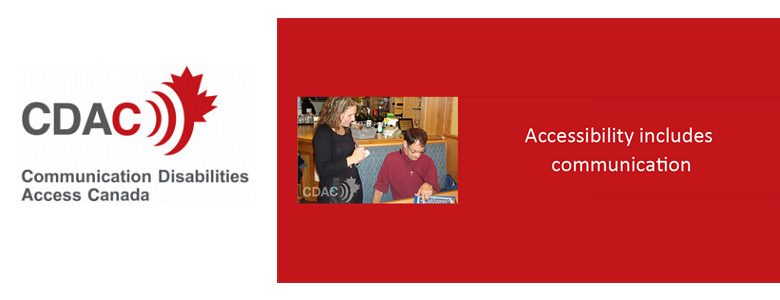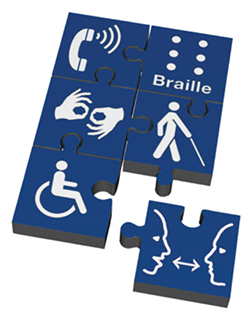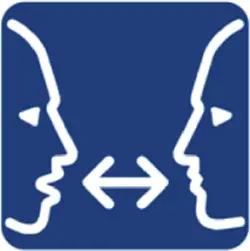
Communication access: the final frontier in accessibility
Glenda Watson Hyatt, who lives in Vancouver (British Columbia), is the Social Media Coordinator with Communication Disabilities Access Canada. Glenda will talk us through the awareness campaign Communication Access Now.


But I find the inability to clearly communicate verbally is far more disabling. For some reason, which continues to baffle me, the majority of our society links the ability to speak with the ability to hear and to understand. When many people encounter someone who has troubles speaking they seem to assume the person does not understand, and automatically begin talking louder and slower, even use hand gestures as if an impromptu game of Charades has broken out.
As some of you know, not being able to speak clearly causes us much frustration, misunderstanding and isolation. It means each daily interaction people have with others, without even thinking about it, becomes an ordeal for us. Little things like making a hair appointment, ordering an iced mocha latte with skim milk or talking with one’s doctor in private becomes futile, if not impossible.
It means missed opportunities when it comes to socializing, making friends, and finding jobs. This negatively impacts one’s self-esteem and self-confidence, leading to further social isolation.


With funding from the Government of Canada’s Social Development Partnerships Program, CAN promotes communication accessibility for people who have speech and language disabilities (not caused by a hearing loss). Communication Access Now is operated by Communication Disabilities Access Canada (CDAC), a national, non-profit organization that promotes human rights, accessibility and inclusion for people with speech and language disabilities.
Now, as the Social Media Coordinator for CAN, I work closely with Barbara Collier, the Executive Director and founding member of CDAC, and the CAN Regional Coordinators who spread the message about communication access in several areas across the country.
As many of you can likely relate to, those of us with speech and language disabilities face barriers when attempting to access services for several reason, including:
- people may be afraid to talk to us, think we are hard of hearing, and underestimate our abilities,
- they do not know how to communicate with us, and
- they do not know simple things to do to provide access to their service.
Communication Access Now’s overall goal is to improve accessibility to goods, services and opportunities for all Canadians who have speech and language disabilities, not caused by hearing loss. This awareness campaign provides information, education and resources about communication access to various groups, including:
- Government, accessibility legislators and policy makers,
- Businesses, organizations and community services,
- People who have speech and language disabilities and their families, and
- Communication and disability services.
One key piece for the Communication Access Now campaign is the communication access symbol. We are all familiar with the universal wheelchair symbol. And, perhaps to a slightly lesser extent, the Braille symbol for individuals who are vision impaired or blind, the sign language symbol for people who are hearing impaired or Deaf, and so on. But where are we, individuals with speech and language disabilities? We are the missing piece. Subsequently, the communication access symbol has been developed to represent our communication needs.


Businesses, services and organizations can display the symbol to tell customers, clients and patients that they welcome people with communication disabilities, and that they are willing and able to interact with people who have communication disabilities.
The communication access symbol is available for download from the CAN site. The symbol can be displayed anywhere, anytime and by anyone. No requirements need to be met before the symbol can be displayed, for example, in a store window or at a reception area. Feel free to share the symbol with businesses and organizations in your community.
Communication Access Now provides many free resources on its website, including resources for people with communication disabilities. I would like to share two resources that have boosted my confidence when interacting with others; hopefully these resources will enable you to feel more empowered, too.
The first is the Communication Rights, which tell businesses and organizations what we expect them to do, in terms of communication, so that we can use their services. The Communication Rights are based on input from people with various kinds of speech and language disabilities; they are not a legal document.
(Related vocabularies for communicating about accessibility and rights are available for free download.)
The second resource that I found empowering is the Communication Access Card. On this card, you can print instructions that explain to others what to do when communicating with you. It is a handy card to have because it can save frustration and time. More information about the card is available on the site.
How can you become involved in Communication Access Now?
I invite you to participate in CAN by:
- Learning about your communication access rights.
- Following us on Twitter and Liking us on Facebook.
- Sharing the free e-learning modules with businesses and services in your community.
- Encouraging businesses to display the communication access symbol in their windows.
As a person with a speech disability, I’ve often been dismissed and devalued. Now is the time for all of us to unite, to stand up and to be heard. Together we can blast through this last frontier in accessibility.
We need and have a right to communication access. Now.
By Glenda Watson
Get in touch by messaging us on Facebook, tweeting us @DHorizons, emailing us at editor@disabilityhorizons.com or leaving your comments below.